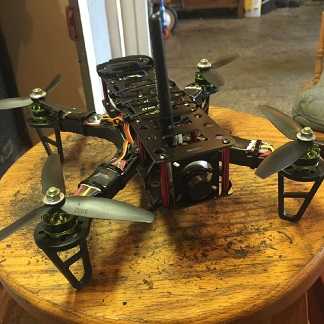Projects> The Drone Collection
250mm
I had to build the first drone myself. I heard too much about people breaking theirs after the first flight and not being able to put it back together. I had zero interest at the time in getting one of the big-heavy ones for taking pictures. The second I saw drone racing, it seemed like you were sitting in the cockpit of the RC quadcopter. Some racing drones can fly up to 90mph, while being nimble as a hummingbird. It took me about two months to collect all the "right" pieces to solder together and a few days to figure out the wiring and power up the flight controller. Once I got all the connections right, the thing went together and I was balancing it and adjusting auto-level settings. I flew it a few times with wiring hanging out and no cage on the top.
This was the drone that I learned on by flying in my garage. I built it and learned to fly before the next summer, which took about four months before I was comfortable enough to fly outside. It took another year before I was comfortable flying with goggles on (FPV flight). My son would be my flight spotter, by watching the area I was flying for people and animals. I purchased the parts to make a ground station, so he could watch my adventures. We started trading places when there were one or two batteries left, so he could learn to fly.
I crashed this thing so many times. It was probably completely rebuilt four times.


220mm
The second drone was one I flew the most overall in my time doing FPV flying. It was nimble and fast. Needless to say that I learned to keep a nice cache of propellers and spare parts. I was still using my same controller and didn't have a need to upgrade, as it was compatible with all my drones. I started wanting newer video equipment, but it wasn't required unless something broke. So I started being more risky with my flying and getting more freestyle. I still find it hard to fly without auto-leveling.

This drone required some better skills with soldering and computing. It was this drone that made me want to start going to the RC track every week to race other people. There's infrared sensors on the gates and they are triggered when your drone passes, then logged into a computer. I ended up not being very good at this, with the skill that most others were, so I went back to flying at the local school and parks. I put together a pretty cool travel-case for this drone from one of the Call of Duty Black Ops top-level purchases that year, which included a drone. I still have the drone and it never really flew at all, but the box is working well.

The other drones
The others I didn't build include a 250mm Vortex Racing drone and two micro drones, which have been the most fun for those cold and windy days. The Vortex and I have issues, so it hasn't seen more than two flights since I got it. The micro ones have been used to set up drone races in the garage or just fly around the house and annoy the pets. They are self-leveling and have the same functions as the bigger ones (agility and camera). The micro-drones are probably the best way to learn how to fly drones for under $100. I wanted to build one of these, but figured they probably make them better and cheaper than I can build. Get one that doesn't have a camera to learn to fly, then get another with a camera and a small video monitor to learn FPV flight. Stepping into a bigger drone will be easy after that.

